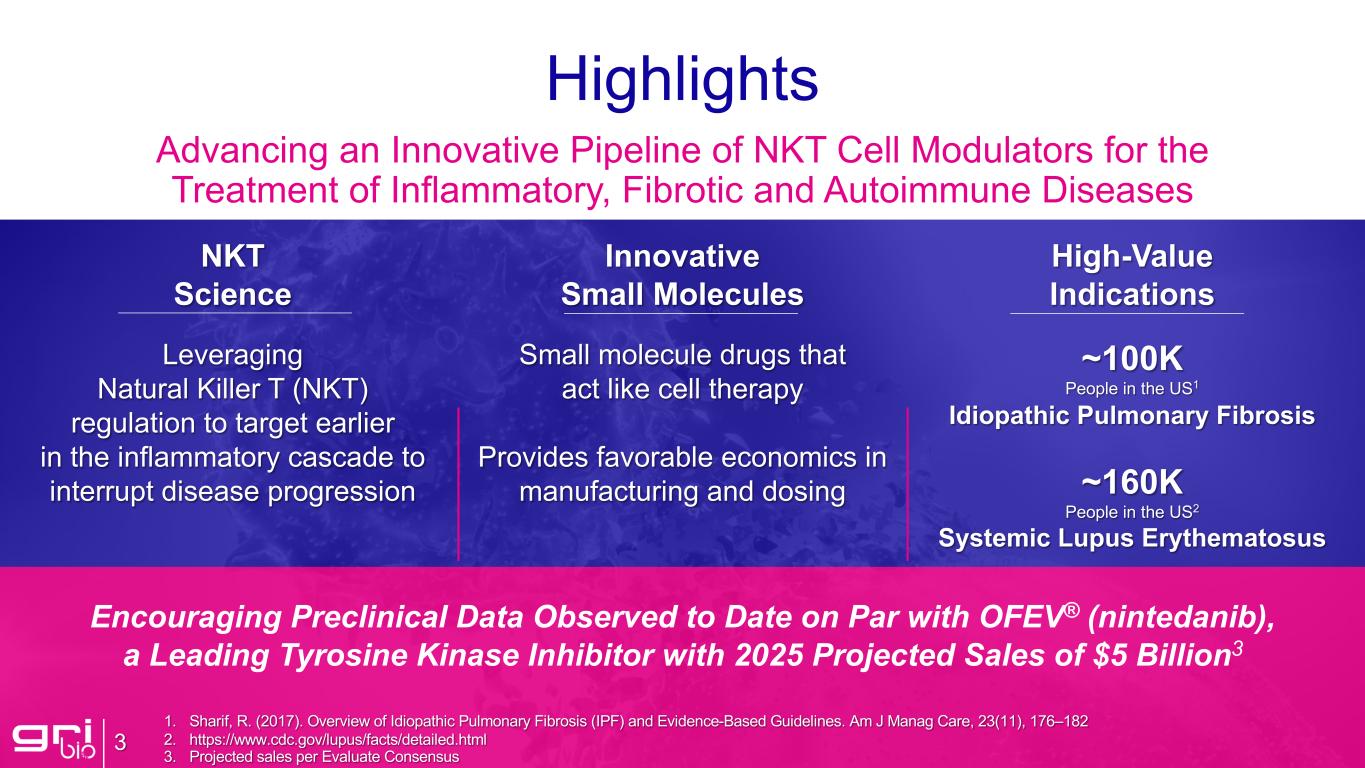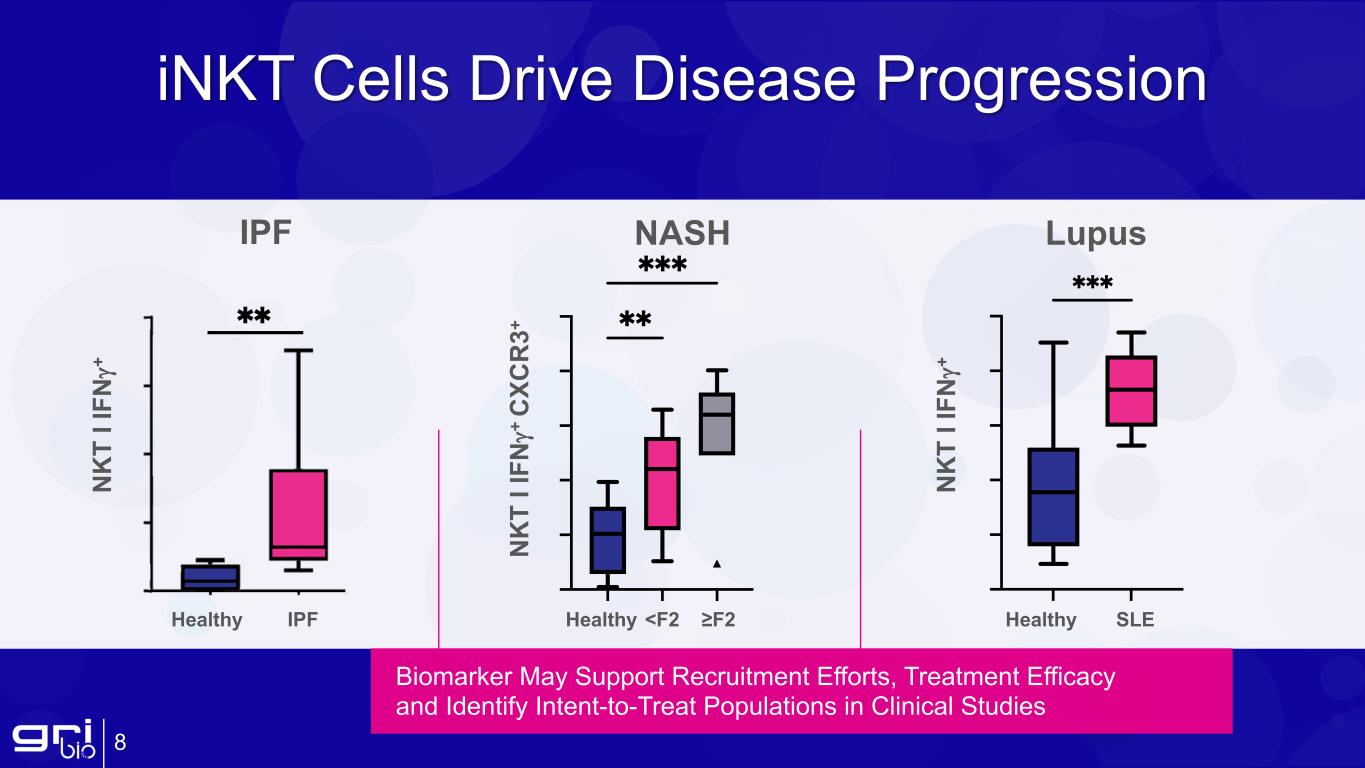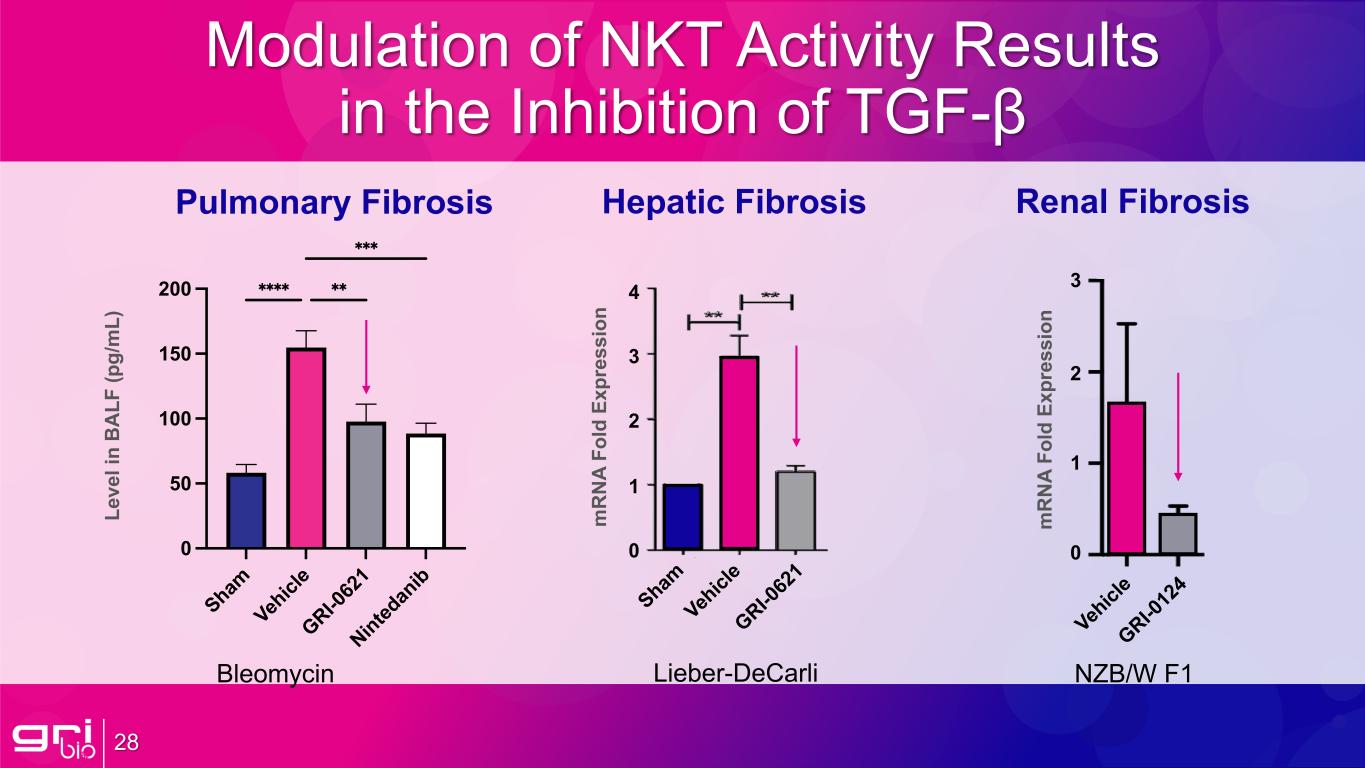
A New Approach to Inflammatory Diseases NASDAQ: GRI | gribio.com January 2024 Corporate Presentation

Forward Looking Statements This presentation is for informational purposes only and is not an offer to sell or a solicitation of an offer to buy any securities of GRI Bio, Inc. (“GRI” or the “Company”). This presentation contains “forward-looking statements” within the meaning of the "safe harbor" provisions of the Private Securities Litigation Reform Act of 1995. Forward-looking statements may be identified by the use of words such as “anticipate,” “believe,” “contemplate,” “could,” “estimate,” “expect,” “encouraging,” “intend,” “seek,” “may,” “might,” “plan,” “potential,” “predict,” “project,” “target,” “aim,” “should,” "will,” “would,” or the negative of these words or other similar expressions. These forward-looking statements are based on GRI’s current beliefs and expectations. Such forward-looking statements include, but are not limited to, statements regarding: GRI’s expectations with respect to financial results, our need for additional capital to fund our operations, our inability to obtain additional capital on acceptable terms, or at all, our ability to continue as a going concern, and our need to liquidate if we fail to obtain adequate funding (which could result in our stockholders receiving no value for their investment), evaluations and judgments regarding intellectual property, future performance, development and commercialization of products and services, the timing, initiation or completion of clinical studies (including the availability of data), whether topline data or the results of any preclinical studies or earlier clinical trials, of GRI products or otherwise, will be indicative of final data or later clinical trials, the potential benefits and impact of GRI's products and services, potential regulatory approvals and the timing of such approvals, the expected timing for the launch of a Phase 1a/b study on GRI-0803, the expected timing for IND filing for GRI-0803, the expected timing for topline data from the Phase 2a biomarker study on GRI-0621 and Phase 1a/b study on GRI-0803, and the size and potential growth of current or future markets for GRI’s products and services and any implications that a future strategic transaction of GRI or GRI’s pipeline would be comparable to any other transaction. Actual results may differ from the expectations, estimates and projections expressed by GRI herein and consequently, you should not rely on these forward-looking statements as predictions of future events. These forward-looking statements are subject to inherent uncertainties, risks and assumptions that are difficult to predict, including, without limitation: (1) the inability to maintain the listing of GRI’s common stock on the Nasdaq Capital Market; (2) changes in applicable laws or regulations; (3) the inability of GRI to raise financing in the future; (4) the success, cost and timing of GRI’s product development activities; (5) the inability of GRI to obtain and maintain regulatory clearance or approval for their products, and any related restrictions and limitations of any cleared or approved product; (6) the inability of GRI to identify, in-license or acquire additional technology; (7) the inability of GRI to compete with other companies currently marketing or engaged in the development of products and services that GRI is currently developing; (8) the size and growth potential of the markets for GRI’s products and services, and its ability to serve those markets, either alone or in partnership with others; (9) inaccuracy in GRI’s estimates regarding expenses, future revenue, capital requirements and needs for additional financing; (10) GRI’s financial performance; and (11) other risks and uncertainties indicated from time to time in GRI’s filings with the U.S. Securities and Exchange Commission (the ‘SEC”), including the risks and uncertainties described in the “Risk Factors” section of GRI’s most recent Annual Report on Form 10-K and Quarterly Reports on Form 10-Q and subsequent filed reports. Forward-looking statements contained in this presentation are made as of this date, and the Company undertakes no duty to update such information except as required under applicable law. This presentation includes information and statistics regarding market participants in the sectors in which GRI competes and other industry data which was obtained from third-party sources, including reports by market research firms and company filings. None of the information provided by third-party sources has been independently verified. This presentation may contain trademarks, service marks, trade names and copyrights of other companies, which are the property of their respective owners. The use or display of any third-party’s trademarks, service marks, trade names or products in this presentation is not intended to, and does not imply, a relationship with GRI, or an endorsement or sponsorship by GRI. Solely for convenience, the trademarks, service marks and trade names referred to in this presentation may appear without the ®, TM or SM symbols, but such references are not intended to indicate, in any way, that GRI will not assert, to the fullest extent under applicable law, their rights or the right of the applicable licensor to these trademarks, service marks and trade names. 2

Highlights Advancing an Innovative Pipeline of NKT Cell Modulators for the Treatment of Inflammatory, Fibrotic and Autoimmune Diseases Encouraging Preclinical Data Observed to Date on Par with OFEV® (nintedanib), a Leading Tyrosine Kinase Inhibitor with 2025 Projected Sales of $5 Billion3 3 1. Sharif, R. (2017). Overview of Idiopathic Pulmonary Fibrosis (IPF) and Evidence-Based Guidelines. Am J Manag Care, 23(11), 176–182 2. https://www.cdc.gov/lupus/facts/detailed.html 3. Projected sales per Evaluate Consensus NKT Science Innovative Small Molecules High-Value Indications Leveraging Natural Killer T (NKT) regulation to target earlier in the inflammatory cascade to interrupt disease progression Small molecule drugs that act like cell therapy Provides favorable economics in manufacturing and dosing ~100K People in the US1 Idiopathic Pulmonary Fibrosis ~160K People in the US2 Systemic Lupus Erythematosus

Programs Class Indication Preclinical Phase 1 Phase 2 Phase 3 Status GRI-0621 Interim data H1 2024 Full topline data H2 2024 GRI-0803 Target IND filing in H1 2024 Topline data from Phase 1a/b expected H2 2024 GRI-NKT Multiple pipeline expansion opportunities Pipeline Targeting High-Value Indications in Need of Innovation Phase 2a Biomarker Study Type 1 invariant NKT (iNKT) Antagonist Idiopathic Pulmonary Fibrosis (IPF) Type 2 NKT Agonist Initial Focus: Systemic Lupus Erythematosus (SLE) Type 2 NKT Agonists Library 500+ Proprietary Compounds to Fuel a Growing Pipeline 4 Multiple Indications

NKT Cells for Immune Regulation 5 Novel Immune Mechanism to Regulate the Adaptive-Innate Immune Axis & Reset Dysfunctional Immune Responses Innate Immune System Adaptive Immune System T cells B cells Type 2 NKT iNKT Macrophages DC Eosinophil Basophil Neutrophil NK Crosstalk Adaptive ImmunityInnate Immunity • Non-specific • Fast to respond (hours) • Activated by ‘danger’ signals • First line of defense • Specific • Slow to respond (days) • Activated by specific pathogen recognition • Generates immune memory Regulating NKT Cells is a Selective Approach to Immunomodulation via Resetting the Immune Response

6 Targeting iNKT Cells Upstream of Key Fibrotic Targets iNKT is a key driver of propagating inflammatory/fibrosis cascade Downregulating iNKT provides potential for downstream benefits, including immune resolution and homeostasis Provides Potential Competitive Advantage IL-4 / IL-13 (Ph3: Lebrikizumab) IFNg / GM-CSF / IL-17A NLRP3 (Ph1: multiple) OPN CTGF (Ph2: SHR-1906) Wnt/Hh (Ph2: LTP001) (Ph2: ENV-101) LPA / ATX (Ph3: HZN-825) (Ph3: BMS-986278) (Ph2: BBT-877) (Ph2: Cudetaxestat) TGF-b (Market: Perfenidone) (Market: Nintedanib) (Ph3: BI-1015550) (Ph2: Bexotegrast) Type 2 NKT cell B cell (Ph2: Lanalumab) Neutrophil Myeloid MØ Myofibroblast Epithelium Injury ECM Deposition Fibrosis (GRI-0621) Targeting Earlier in the Inflammatory Cascade D ow ns tre am T ar ge ts iNKT

7 iNKT Cells: Top of the Inflammatory Cascade Type 1 & 3 Immune Responses Key cytokines involved: TGF-β GM-CSF IL-17A Type 2 Immune Responses Key cytokines involved: IL-4 IL-5 IL-13 Repeated or prolonged injury drives a healing process towards chronic inflammation iNKT cells activate immune cells at site of tissue injury Immune cells secrete inflammatory cytokines that activate macrophages TGF-β1, IL-17A, and IL-13 cause differentiation of fibroblasts and ECM deposition Chronic inflammation promotes further injury and fibrosis Eosinophil ILC2 CD4+ Th2 iNKT cell Neutrophil NETs CD4+ Th17 Macrophage Fibroblasts Myofibroblast TGF-β1 IL-13

iNKT Cells Drive Disease Progression 8 Healthy IPF N K T I I FN g+ N K T I I FN g+ IPF NASH Lupus Healthy SLEHealthy <F2 ≥F2 N K T I I FN g+ C XC R 3+ Biomarker May Support Recruitment Efforts, Treatment Efficacy and Identify Intent-to-Treat Populations in Clinical Studies ✱✱ ✱✱✱ ✱✱✱

9 GRI-0621 Targets iNKT to Restore Homeostasis Type 1 & 3 Immune Responses Type 2 Immune Responses GRI-0621 inhibits the activity of iNKT cells early in the inflammatory cascade to prevent cytokine release, cellular infiltration, and interrupts disease progression at the source Resolution of chronic inflammatory response and immune system returning to homeostasis without systemic immunosuppression Macrophage Fibroblasts TGF-β1 IL-13 Most current therapies work through TFG-β regulation and fail to address type 2 immune responses GRI-0621

GRI-0621 Idiopathic Pulmonary Fibrosis (IPF) Ongoing Phase 2a biomarker study with interim data expected H1 2024 and topline data H2 2024 Leveraging FDA agreed 505(b)(2) regulatory pathway Orphan indication with ~40K newly diagnosed cases annually1 10 1. Sauleda J, Núñez B, Sala E, Soriano JB. Idiopathic Pulmonary Fibrosis: Epidemiology, Natural History, Phenotypes. Med Sci (Basel). 2018 Nov 29;6(4):110. doi: 10.3390/medsci6040110. PMID: 30501130; PMCID: PMC6313500

The Need in Idiopathic Pulmonary Fibrosis 11 A Rare Chronic Progressive Pulmonary Disease with Abnormal Scarring of the Lungs Blocking the Movement of Oxygen into the Bloodstream Significant side-effects, limited compliance and no impact on survival3 Despite challenges, total 2022 sales were ~$4.3 billion combined4 Current Treatments are Limited with Only 2 Approved Drugs 8/10 die within 5 years of diagnosis220% Age of onset1~66 5/10 die within 2-3 years of diagnosis250% Survival without a lung transplant30% 1. Castriotta, R. J. (2010). Workshop on Idiopathic Pulmonary Fibrosis in Older Adults. Chest, 138(3), 693–703 2. Sharif, R. (2017). Overview of Idiopathic Pulmonary Fibrosis (IPF) and Evidence-Based Guidelines. Am J Manag Care, 23(11), 176–182 3. Maher, T. M. (2021). Global incidence and prevalence of idiopathic pulmonary fibrosis. Respiratory Research, 22(197) 4. Companies’ earnings reports

12 GRI-0621 for the Treatment of Idiopathic Pulmonary Fibrosis Established safety profile as an oral formulation GRI-0621 is an oral formulation of an FDA-approved topical dermatology product, tazarotene Prior late-stage studies of an oral formulation of tazarotene demonstrated favorable safety profile in ~1,700 subjects Small molecule RAR-βɣ dual agonist that inhibits the activity of human iNKT cells Extensive IP protection with issued medical use patents and market LOE through 2036 iNKT inhibition demonstrated fibrosis resolution in multiple animal models

0.0 0.1 0.2 0.3 0.4 0.5 ✱✱✱✱ ✱✱✱✱ ✱✱ 0.0 0.1 0.2 0.3 ✱✱✱ ✱✱✱ ✱ 0 50 100 150 200 ✱✱✱✱ ✱✱ ✱✱✱ Modulation of NKT Activity Inhibits Inflammation and TGF-b 13 C el l N um be rs (1 06 /m L) in B A LF WBC Neutrophils Monocytes Lymphocytes TG F- b in B A LF (n g/ m g) Sham Vehicle GRI-0621 Nintedanib 0.00 0.01 0.02 0.03 0.04 0.05 ✱✱✱ ✱✱ ✱✱✱ 0.00 0.05 0.10 0.15 ✱✱✱ ✱ ✱ Preclinical Data on Par with OFEV® (nintedanib), a Leading Tyrosine Kinase Inhibitor with 2025 Projected Sales of $5 Billion1 1. Projected sales per Evaluate Consensus

Sh am Ve hic le GR I-0 62 1 Ni nte da nib 0 1 2 3 4 ✱✱✱✱ ✱✱ ns Targeting iNKT Cells Upstream of Key Fibrotic Targets Provides Potential Competitive Advantage 14 IPF Animal Model: GRI-0621 significantly reduces inflammation, TGF-b, and fibrosis in a bleomycin model of pulmonary fibrosis and compares favorably to Nintedanib iNKT is a key driver of propagating inflammatory/fibrosis cascade Downregulating iNKT provides potential for downstream benefits, including immune resolution and homeostasis Fi br os is (A sh cr of t S co re )

Ongoing Phase 2 Study in IPF 15 Screening Treatment Follow Up Day ≤ -28 -4 weeks Day 1 to 84 12 weeks with planned interim analysis Day 98 2 weeks 2 arms: 4.5 mg + placebo Enroll 36 Patients in Phase 2 IPF Trial Patients: 36 IPF patients on background IPF therapy Dosing: 4.5mg and placebo dosed orally 1x daily for 12 weeks Design: 2 arm RCT 2:1 randomization (24:12) Interim Analysis: when 8 of 12 placebo treated patients have completed 6 weeks of treatment Endpoints Primary Endpoint: Safety, percent inhibition iNKT in blood (PBMC) at 6 and 12 weeks and lung (BAL fluid) at 12 weeks Exploratory Endpoints: Changes in serum biomarkers at 6 and 12 weeks (collagen degradation biomarkers, cytokines, NKT); FVC at 6 and 12 weeks

Recent Acquisitions in IPF Suggest Potential for Significant Upside 16 Company Partner Stage (Year) Upfront Total Deal Phase 3 (2019) $3.95B $3.96B plus $1.1B investment undisclosed milestones Phase 2 (2019) $390M $1B milestones + royalties Phase 1 (2019) $50.57M $1.25B milestones Preclinical (2020) $17M $360M + royalties Preclinical (2022) $255M total payment Preclinical (2018) Preclinical (2020) $100M $20M R&D option agreement Upfront licensing fee for IPF program(s) Preclinical (2021) NA $518M upfront, milestones

GRI-0803 Initial Focus on Systemic Lupus Erythematosus (SLE) 17 Target IND filing in H1 2024 with topline data from Phase 1a/b expected H2 2024 Extensive IP protection with issued composition of matter and use patents and market LOE through 2038

The Need in Systemic Lupus Erythematosus 18 The most common form of lupus, SLE, is an autoimmune disease in which the immune system attacks its own tissue and organs DIAGNOSIS Number of all lupus cases2 70% AGE RANGE Commonly affects women of childbearing age1 15 - 44 PREVALENCE Confirmed as definite SLE1 ~160K Current treatments are limited, consisting primarily of immunosuppressive therapies Only 2 drugs approved for SLE in the past 50 years Can Affect the Whole Body Lungs Kidneys Skin Heart Blood Muscle and joints Severe abdominal pain Hair loss High fever Abnormal headache Mouth and nose ulcers Kidney nephritis is a key driver of disease morbidity and represents potential target 1. https://www.cdc.gov/lupus/facts/detailed.html 2. https://www.lupus.org/resources/what-is-systemic-lupus-erythematosus-sle

Type 2 NKT Agonist Observed to Inhibit Lupus Nephritis in Model 19 Control Type 2 NKT Agonist Control (7/9) Type 2 NKT Agonist (10/10) ü The Most Common Manifestation of Lupus Nephritis & Renal Damage, Proteinuria, Improved ü Improvement in Auto-Antibodies & Overall Survival Weeks Control Type 2 NKT Agonist Control Type 2 NKT Agonist ü Inflammation Decreased ü Interstitial Anatomy Improved ü Collagen Deposition & Fibrosis Stopped Control Type 2 NKT Agonist

20 Rapidly Advancing into the Clinic Target IND Filing in H1 2024 with Topline Data Expected H2 2024 Validate bioanalytical methods Complete cGMP manufacturing Complete toxicology studies Steps Toward IND Filing

Pipeline Expansion Opportunities 21 Type 2 NKT Agonists For Autoimmunity Potential Future Indications and Patient Populations (United States) 3M 1.5M 1.6M <200K <20K Multiple Sclerosis Rheumatoid Arthritis Inflammatory Bowel Disease Insulin Dependent Diabetes Mellitus Amyotrophic Lateral Sclerosis

Proven Leadership Team Marc Hertz, PhD Chief Executive Officer Vipin Kumar, PhD Prof. UCSD | CSO Albert Agro, PhD Chief Medical Officer 20+ years immunotherapy experience (fibrosis, inflammation, autoimmunity, allergy and oncology) Drug discovery through Phase 3 C-level & board positions at Pharmexa, Multimeric Biotherapeutics, GemVax & Evozym An internationally recognized leader in NKT cell research, regulation and autoimmunity Academic appointments at UCSD, UCLA, La Jolla Institute for Allergy & Immunology Published more than 130 peer- reviewed articles 20+ plus years in drug development; CEO Sublimity Therapeutics Played an instrumental role as C- level executive in $624 million sale of Cynapsus to Sunovion in 2016 Filed and FDA approval of 7 NDAs, 40 INDs, 30 CTAs Leanne Kelly Chief Financial Officer 20+ years financial executive leading private & public life science, technology and e-commerce companies Strong background in healthcare finance and accounting Audit and advisory experience 22

Multiple Potential Upcoming Value-Driving Milestones 23 FDA IND Clearance and Start Phase 1a/b Q4 2023 Q1 2024 Q2 2024 Q3 2024 Q4 2024 Completion of IND Enabling Studies Potential for Data Presentations at Scientific Congresses Interim Data from Phase 2a Biomarker Study GRI-0803 GRI-0621 Topline Results from Phase 2a Biomarker Study Topline Results from Phase 1a/b Study Launched Phase 2a Biomarker Study ✔

Summary 24 Elevating Clinical Stage Biotechnology Company Advancing Innovative Pipeline Across Multiple Orphan and High-Value Inflammatory, Fibrotic and Autoimmune Diseases NKT Science Leading NKT regulation technology targeting earlier in the inflammatory cascade to interrupt disease progression High-Value Indications Clinical pipeline in potential high- value indications with multiple pipeline expansion opportunities Proven Team Team with proven NKT, immunology and drug development experience We Believe NKT Science is Compelling to Fundamental Institutional Investors and Big Pharma Partners

A New Approach to Inflammatory Diseases NASDAQ: GRI | gribio.com Thank You! Investor Relations JTC Team 833-475-8247 gri@jtcir.com

Natural Killer T Cells 26 T cells NK cells Neutrophil Epithelial Injury MØPro-fibrotic Cytokines NLRP3 Inflamma- some OPN & Hedgehog Myo- fibroblast iNKT Two Types: iNKT and Type 2 NKT Type 2 NKT iNKT TNFa IL-17A IL-6 LCN2 Proteinuria Cellular Infiltration Into Tissue Collagen Deposition & Fibrosis Anti- dsDNA Antibodies pDC Interferon I Signaling Immune Cells that Bridge the Innate and Adaptive Immune Responses Significantly Increased in Patients with Chronic Inflammatory Conditions Regulate the Activity of Other Immune Cells and ‘Reset’ an Aberrantly Activated Immune Response Type 2 NKT

27 Type 1 & 3 Immune Responses Type 2 Immune Responses iNKT: Mechanism of Action Tissue Injury ECM Deposition Neutrophil iNKT cell ILC2 Eosinophil CD4+ Th2 Macrophage FibroblastsFibroblasts Macrophage NET Myofibroblast CD4+ Th17IL-17A TGF-β1 NLRP3 Inflammasome IL-13 Alarmins IL-25 IL-33 TSLP IL-17A IFN-𝛾 TNF-𝛼 GM-CSF IL-17A IL-17A EMT (Hh-Wnt signaling) IL-4 IL-5 IL-4, IL-5, IL-13 IL-5 IL-4 IL-5 IL-13 ROS+ IL-1β, IL-6 IL-23

Modulation of NKT Activity Results in the Inhibition of TGF-β 28 Lieber-DeCarliBleomycin NZB/W F1 Pulmonary Fibrosis Hepatic Fibrosis Renal Fibrosis GRI-0 62 1 m R N A Fo ld E xp re ss io n Le ve l i n B A LF (p g/ m L) Veh icl e GRI-0 12 4 3 2 1 0 m R N A Fo ld E xp re ss io n Sh am Ve hic le GR I-0 62 1 Ni nte da nib 0 50 100 150 200 ✱✱✱✱ ✱✱ ✱✱✱ Veh icl e Sham 0 1 2 3 4